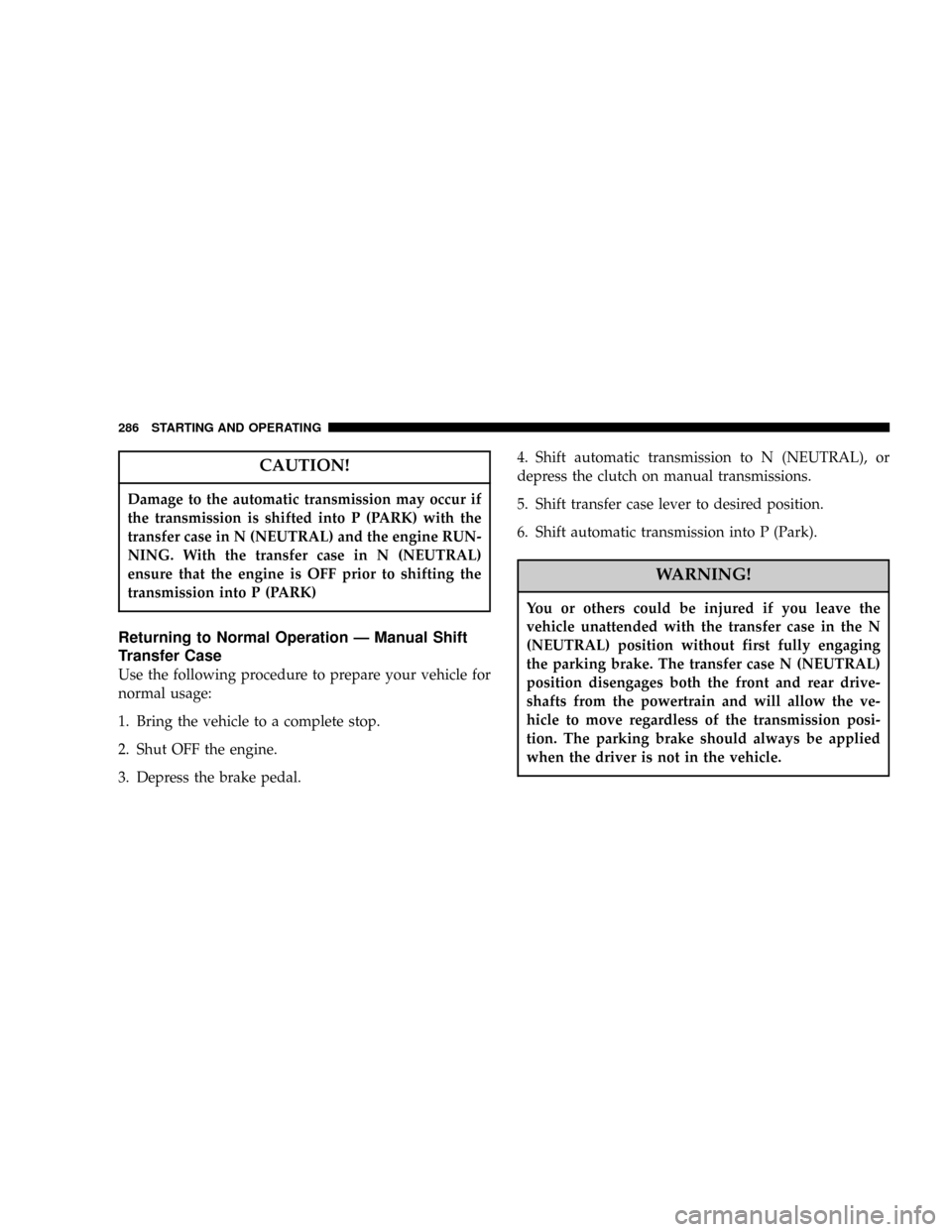Page 273 of 429

2500/3500 Models
²
The Axles on 2500/3500 Modelsare trailer tow ready
andDO NOT REQUIREany special axle lubes or
additives.
Trailer Towing Recommendations
²
All trailer hitches should be professionally installed on
your vehicle.
²Safety chains must always be used between your
vehicle and trailer.
²Donotinterconnect the hydraulic brake system or
vacuum system of your vehicle with that of the trailer.
This could cause inadequate braking and possible
personal injury. An electrically±actuated electric trailer
brake controller is recommended.
²Trailer brakes are recommended for trailers over 1000
lbs (454 kg) and are required for trailers in excess of
2,000 lbs (907 kg)
²Use an approved wiring harness connector on the
trailer. Standard equipment on all RAM pickup mod-
els provides a 4-way trailer tow connector located
under the bumper. This connector contains the follow-
ing vehicle circuits: park/tail lamps, left stop/turn
lamp, right stop/turn lamp, and ground. With the
optional Trailer Tow Prep package a 7-way connector
is provided with the following additional circuits:
backup lamp, trailer battery and electric brake.
NOTE:Connect trailer lighting and brakes using factory
harnesses only. Do not cut or splice wiring to the brake
circuits.
STARTING AND OPERATING 273
5
Page 275 of 429

Connecting Trailer Lighting And Electric Trailer
Brakes
NOTE:A 4-way trailer tow connector, located behind
the bumper, is standard equipment on all Ram pickup
models. This connector contains the following vehicle
circuits: park/tail lamps, left stop/turn lamp, right stop/
turn lamp, and ground. With the optional Trailer Tow
Prep package a 7-way connector is also provided with the
following additional circuits: backup lamp, trailer battery
and electric brake.
NOTE:There is also a 4±way connector located under
the instrument panel, located to the left of the brake
pedal that is used for the electric brake. This connector
contains the following vehicle circuits; power ground,
battery, stop lamp switch and electric brake feed. The
4±way is optional with the trailer tow prep package.
CAUTION!
Adding lights or electrical devices to the headlamp/
park lamp circuit can be accomplished by connecting
to the standard 4-way trailer tow connector located
behind the rear bumper. The maximum current ca-
pacity for the park lamp circuit should not exceed 15
amps total (a typical park lamp bulb can draw from
0.5 to 1.0 amperes of current).
No connections can be made to the headlamp switch
itself, because it is not designed for high current
applications. Connections to the headlamp switch
will cause the exterior lights to malfunction.
STARTING AND OPERATING 275
5
Page 278 of 429
Trailer Towing Mirrors Ð If Equipped
These mirrors are designed with an adjustable mirror
head to provide a greater vision range when towing
extra-wide loads. To change position inboard or out-
board, the mirror head should be rotated (flipped Out or
In). A small blindspot mirror is integrated onto the main
mirror surface.
Cooling System Tips Ð Trailer Towing
To reduce potential for engine and transmission over-
heating, take the following actions:
²City DrivingÐwhen stopped, put the transmission in
N (Neutral) and increase the engine idle speed.
²Highway DrivingÐreduce your speed.
278 STARTING AND OPERATING
Page 279 of 429

²Air ConditioningÐturn it off temporarily.
²Hilly TerrainÐTurn overdrive off.
See Cooling System Operating information in the Service
and Maintenance section of this manual for more infor-
mation.
Automatic Transmission Oil Temperature Warning
Light
All vehicles with automatic transmissions are equipped
with a transmission sump oil temperature sensor and
warning light. If elevated transmission temperatures are
encountered, the engine controller will select the most
desirable gear until the transmission temperatures are
reduced. If transmission oil temperatures continue to
rise, a warning light located in the instrument cluster will
illuminate. If this should occur, stop the vehicle, shift to
Neutral, and run the engine at idle or faster until the light
goes off.
Towing With An Automatic Transmission
Vehicles equipped with an automatic transmission may
shift into and out of Overdrive, or a lower gear, when
driving in hilly areas, when heavily loaded, or when
towing into heavy winds.
When this condition occurs, select TOW/HAUL mode or
shift into a lower gear to prevent excessive transmission
wear and/or overheating, and to provide better engine
braking.
NOTE:Do not exceed the following RPM while manu-
ally downshifting:
²5800 rpm with 3.7L engines.
²5800 rpm with 4.7L engines.
²5600 rpm with 5.7L engines.
STARTING AND OPERATING 279
5
Page 283 of 429
conditions permit. Do not exceed 40 mph (64 km/h). The
operator should always maintain a safe stopping distance
and allow adequate passing clearance.
Methods For Removing SnowOperating Tips
Under ideal snow plowing conditions, 20 mph (32 km/h)
should be maximum operating speed. The operator
should be familiar with the area and surface to be
cleaned. Reduce speed and use extreme caution when
plowing unfamiliar areas or under poor visibility.
NOTE:During snowplow usage on vehicles equipped
with an overhead console module, the outside tempera-
ture display will show higher temperatures than the
outside ambient temperature. The higher displayed tem-
perature is due to blocked or reduced airflow to the
underhood ambient temperature sensor by the snow-
plow. This is common and outside temperature display
operation will return to normal when the snowplow is
removed.
STARTING AND OPERATING 283
5
Page 284 of 429

General Maintenance
Snowplows should be maintained in accordance with the
plow manufacturer's instructions. Whenever the plow is
disconnected from the vehicle, coat the exposed angling
cylinder rods with chassis lubricant. The lift cylinder
should be extended upward and chassis lubricant ap-
plied to the lift rod. The hydraulic hoses interconnect to
keep the couplers clean.
Keep all snowplow electrical connections and battery
terminals clean and free of corrosion.
When plowing snow, to avoid transmission and driv-
etrain damage, the following precautions should be ob-
served.
²Operate with transfer case in 4L when plowing small
or congested areas where speeds are not likely to
exceed 15 mph (24 km/h). At higher speeds operate in
4H.
²Do not shift the transmission unless the engine has
returned to idle and wheels have stopped. Make a
practice of stepping on the brake pedal before shifting
the transmission.
RECREATIONAL TOWING Ð 4±WHEEL DRIVE
VEHICLES (BEHIND MOTORHOME, ETC.)
CAUTION!
Internal damage to the transfer case will occur if a
front or rear wheel lift is used when recreational
towing.
NOTE:Both the Manual Shift and Electronic Shift
transfer cases must be shifted into Neutral (N) for
recreational towing. Automatic transmissions must be
placed in P (Park) position for recreational towing.
Manual transmissions must be left in gear (not in neutral)
284 STARTING AND OPERATING
Page 285 of 429

for recreational towing. Refer below for the proper trans-
fer case Neutral shifting procedure for your vehicle.
Recreational Towing Procedure Ð Manual Shift
Transfer Case Ð If Equipped
Use the following procedure to prepare your vehicle for
recreational towing:
CAUTION!
It is necessary to follow these steps to be certain that
the transfer case is fully in N (NEUTRAL) before
recreational towing to prevent damage to internal
parts.
1. Bring the vehicle to a complete stop.
2. Shut OFF the engine.
3. Depress the brake pedal.4. Shift automatic transmission to N (NEUTRAL), or
depress the clutch on manual transmissions.
5. Shift transfer case lever into N (NEUTRAL).
6. Start the engine.
7. Shift automatic transmission into Reverse (R).
8. Release brake pedal for five seconds and ensure that
there is no vehicle movement.
9.
Repeat steps 7 and 8 with the transmission in Drive (D).
10. Shut OFF the engine and place the ignition key to the
unlocked OFF position.
11. Shift automatic transmission into P (PARK).
12. Apply the parking brake.
13. Attach vehicle to tow vehicle with tow bar.
14. Release the parking brake.
STARTING AND OPERATING 285
5
Page 286 of 429

CAUTION!
Damage to the automatic transmission may occur if
the transmission is shifted into P (PARK) with the
transfer case in N (NEUTRAL) and the engine RUN-
NING. With the transfer case in N (NEUTRAL)
ensure that the engine is OFF prior to shifting the
transmission into P (PARK)
Returning to Normal Operation Ð Manual Shift
Transfer Case
Use the following procedure to prepare your vehicle for
normal usage:
1. Bring the vehicle to a complete stop.
2. Shut OFF the engine.
3. Depress the brake pedal.4. Shift automatic transmission to N (NEUTRAL), or
depress the clutch on manual transmissions.
5. Shift transfer case lever to desired position.
6. Shift automatic transmission into P (Park).
WARNING!
You or others could be injured if you leave the
vehicle unattended with the transfer case in the N
(NEUTRAL) position without first fully engaging
the parking brake. The transfer case N (NEUTRAL)
position disengages both the front and rear drive-
shafts from the powertrain and will allow the ve-
hicle to move regardless of the transmission posi-
tion. The parking brake should always be applied
when the driver is not in the vehicle.
286 STARTING AND OPERATING